Rajasthan, a state full of culture , tradition, colours and celebrations. Rajasthani folk dances form an integral part of its rich heritage.
Here we present some of the iconic Rajasthani folk dances that have prevailed throughout the world and marked their essence with their gracefulness.
- Ghoomar
- Bhavai
- Kalbelia
- Kathputli Dance
- Kachchhi Ghodi
- Gair
- Chari
- Chakri
A country as large and diverse as India offers travellers so many different experiences that they could never fit in one visit. While enthusiasts promote their favorite region for their preferred initial destination, no area epitomizes India’s rich culture as well as Rajasthan.
The largest state in the country symbolizes a culture that dates back to the Kings where it was initially characterized as Rajputana. The diverse culture is the result of the rein of several kings including The Rajput, Marathas, and even Muslim rulers.
The liveliness of Rajasthan’s traditions and culture reflects through Folk music and dance. Even now, the culture manoeuvres the beauty of the state with its old traditions and customs.
Recommended Story – Indian Classical Dance Forms
Each form of Folk dance holds significance to its culture and history. The different kinds of folk dances exercised in Rajasthan were introduced with an aim to entertain kings. Every form gracefully depicts mesmerizing movements that leaves the spectators in awe.
Lets get going with the list of Rajasthani folk dances, enjoy!
1. Ghoomar

Ghoomar is a very popular Rajasthani dance form also called as Jhoomer that has even compelled Bollywood to symbolise its exquisiteness by the persistent actors of the industry and promote the Rajasthani tradition along with iconic stories.
The dance involves dancers twirling while moving in and out of a circle. The word ‘ghooma’ represents the twirling movement.
History of Ghoomar Folk Dance
Tribe
People from the Bhil tribe are known to be the first performers of Ghoomer dance. This dance form symbolises the transformation of young girls to womanhood in the Bhil community.
The lavish costumes worn in the dance which have Zari work and embroidery on the Ghagara are a depiction of the prosperity of the Bhil community.
Origin of Ghoomar
- Ghoomar was a dance form that originated in Marwar, Rajasthan.
- It was performed by the Bhil tribe demonstrating their devotion towards Goddess Saraswati.
- It was characterised as the dance performed by the ladies on the occasion of marriages and festivals.
- Initially, it was performed with an aim to entertain the kings of Rajasthan.
- The tradition of swaying and clapping hands with twirling in rounds got adapted by Kacchawaha Clan of Rajputs.
- It was adapted after defeating the king of Jaipur and further proceeding with the co-existence of the form by both the royal tribes.
Present Scenario
The predominant places that the dance form rules are:
- Udaipur
- Kota
- Jodhpur
- Bundi
Significance
In Udaipur, the dance form resembles Garva of Gujarat and in Jodhpur the movement of limbs are jerky. In Kota and Bundi the form represents elegance and slenderness.
Ghoomar dance form expresses the tradition of a new bride’s welcome into the husband’s house.
The form signifies royalty, and was predominantly invented for entertaining kings. Although now it has evolved and is no longer exercised for entertainment purposes but for the promotion of Rajasthani culture across the world.
Costume of Ghoomar
The traditional costume for women involves:
- The women are dressed in beautiful swirling long robes known as ‘Ghagaras’ that is symbolic to this dance form.
- The faces of the women are covered through veils.
- Kundan, mirror or silver pieces of jewellery are used as accessories.
- The vibrant colours on the skirt create a kaleidoscope of colours and exemplify happiness.
- Originally the costume design was above the ankle but now it has evolved and dropped down till the knee length.
2. Bhavai Folk Dance
Bhavai is a beautiful and elegant dance form that captivates people all around the world.
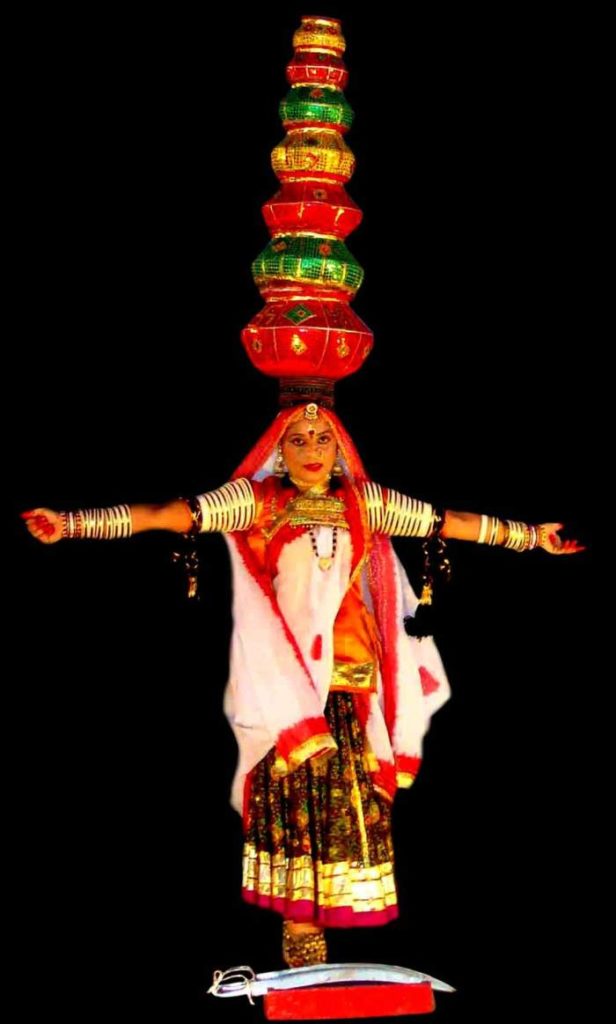
The spectacular view of a woman with seven to eight pots on their heads balancing while their feet are perched on top of the glass, the edge of the sword, or a brass ‘thali’, is extremely mesmerising.
It is a dance form that is performed by women who belong to the Kalbelia, Jat, Meena, Bhil, or Kumhar tribe community.
The males engaged in the dance form are responsible for playing folk songs for the women to sway on. The instruments acclimatised to execute a complete Bhavai dance performance are Pakhawaj, Dholak, Jhanjhar, Sarangi, Harmonium.
The gracefully twirling movements made by the women depict hardships faced by them in order to ensure commercial well-being.
History of Bhavai
Tribe
The various Rajasthani tribes like the Jats, Bhils, Raigars, etc promoted the growth of the dance immensely. It is believed that the Kalbelia tribe is the most proficient in the skilful balancing act of Bhawai Dance of Rajasthan.
Origin of Bhavai
It is believed that women of these tribes in Rajasthan were supposed to venture out a lot in the parched desert areas to fetch water in pitchers from the well which they use to carry on their head. They effortlessly carried these pots across a distance. The inspiration for this format for balancing positions seems to come from these daily chores of ancient times.
Their path was usually filled with thorns, hence the whole chore must have inspired a whole dance format where they balance their feet on different difficult objects. This act now receives recognition internationally.
The first-ever Bhavai dancer was Mrs Krishna Vyas Chhangani, a resident of Jodhpur.
Present Scenario
The dance form involves women dancing with their feet perched in glass or brass thali, it represents those ancient times when their path was usually filled with thorns.
Since the art has been deteriorating with time, the government of Rajasthan is taking necessary measures to revive the fast dying art of traditional dances.
Significance of Bhavai
This dance form is performed by expert professionals during special occasions and festivals. Foreigners can expect an effervescent performance during their time of visit in the state since several reputed hotels offer a closer look towards the culture and ancient traditions of Rajasthan through these performances.
Costume of Bhavai
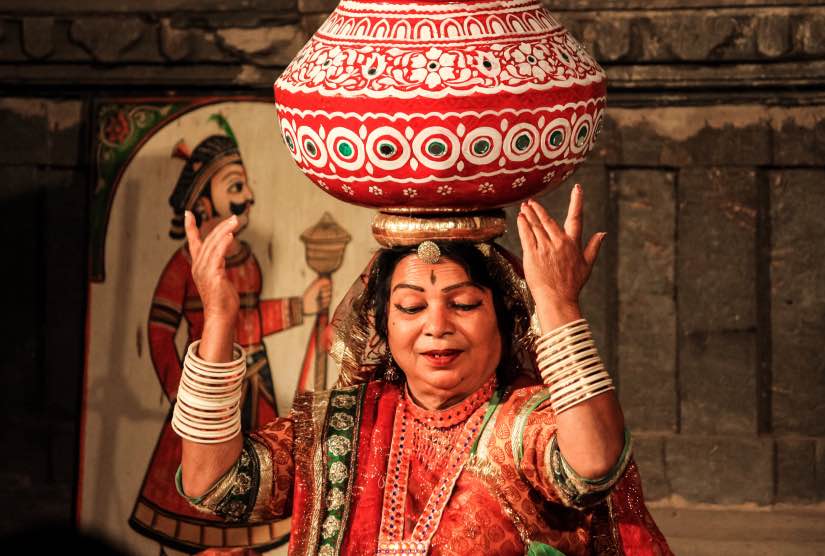
Similarly, how every dance showcases their traditional attires during folk performances of the state, Bhavai also requires the dancer to adorn the traditional attire. The costume is different for men and women and it disseminates the culture.
Recommended Story – Bhangra- The Energetic Folk Dance of Punjab
Women
Since, Rajasthan has been divided into several tribes, irrespective of that the women Bhavai dancers adorn themselves with a beautiful and vibrant attires that include:
- Ghagra Choli:
- The length of the Ghagra is stitched shorter than a traditional lehenga.
- The Cholis are short-sleeved and go up till the waist.
- The embellishments on the Cholis include Gotta Patti work and mirror work along with colourful tassels hanging around the sleeves.
- Authentic silver ornaments:
- The Cholis are short-sleeved hence the left out arms are adorned with ornaments.
- The ornaments include bangles, armlets, a set of at least a dozen on every arm.
- Dupatta: draped along the head and loosely thrown down over the shoulder.
Men
The attire worn by men include:
- Dhoti
- Kurta
- Kamarbandh- a cloth worn as a belt ensemble with mirror work and bright colours
- Sleeveless jacket
- Colourful headdress
3. Kalbelia Folk Dance

The Kalbelia dance is named after the ‘Kalbelia’ tribe in Rajasthan
The dance form consists of swirling, and beautiful movements of hands and foot that leave spectators in awe. It is usually performed at festivals, and on several joyous occasions by the women while the men play instruments and provide beautiful melodies.
The women perform with gracefulness, swirl, and twirl, to the music and showcase the dancer’s flexibility and litheness. As the performance goes on, the tempo of the dance increases along with the pace of the steps.
The dance usually involves at least two pairs who carry out steps in pairs and swap stage presence simultaneously. This way half of the people have time to relax while others perform, not letting the performance slow down.
This dance form is popular worldwide and is a part of UNESCO’s list of the ‘Intangible Cultural Heritage of Humanity’ from 2010 onwards.
History of Kalbelia
Tribe
The tribe usually consists of snake charmers or saperas who are considered to be untouchables. This tribe is known for finding cures for snake bites, trading snake venom and performing snake dances.
Origin of Kalbelia
Kalbelia has its origin in the Thar desert which is still considered to be the hub of Kalbelia performances. This dance form is widely cherished and respected in this region.
The history traces back to a serpent yogic dancer who travelled through deserts. The tribe is believed to have followed the same lifestyle since medieval times. It has been believed that the men perform all other activities and women occasionally dance on the street to earn a living.
Current Situation
The Kalbelia tribe is known to be a nomadic tribe. They prefer to live in makeshift camps called Deras. But, after the Wildlife Act of 1972, the tribe was forced to stop their act of catching snakes limiting their income source to be performances made by women.
The dance is famous in Udaipur, Ajmer, Chittorgarh, and other desert provinces.
Significance
The most interesting facts of the folk dance culture is that it is being practised today to show several variations such as:

- The Kalbelia songs are based on stories inspired by folklore and mythology.
- The dancers are known for their ability to compose lyrics spontaneously and then improvising songs during the performance.
- Gulabo Sapera is considered to be the legendary Kalbelia dancer. She was almost buried as soon as she was born because she was a girl child. She struggled tremendously and due to her incredible performances, she got featured in a French book written by Thierry Robin which was titled “Gulabi Sapera, danseuse Gitane du Rajasthan” (Gulabo Sapera, the gipsy dancer from Rajasthan).
Costume of Kalbelia
- The performers wear an Angrakhi on their upper body with half or full sleeves.
- Their head is covered with Odhani.
- They wear a long skirt which is called a Lehenga.
- The whole dress is essentially black in colour with red laces.
- It employs silver thread sewed in different patterns on the black dress.
This makes the dress resemble the black snake that has white spots along with other colourful patterns and designs along with mirror work turning out to the centre of attention.
The dancers usually wear traditional jewellery. They wear jewellery around their neck and head along with Maang-Tika. The jewellery also includes bangles and armlets.
4. Kathputli Folk Dance
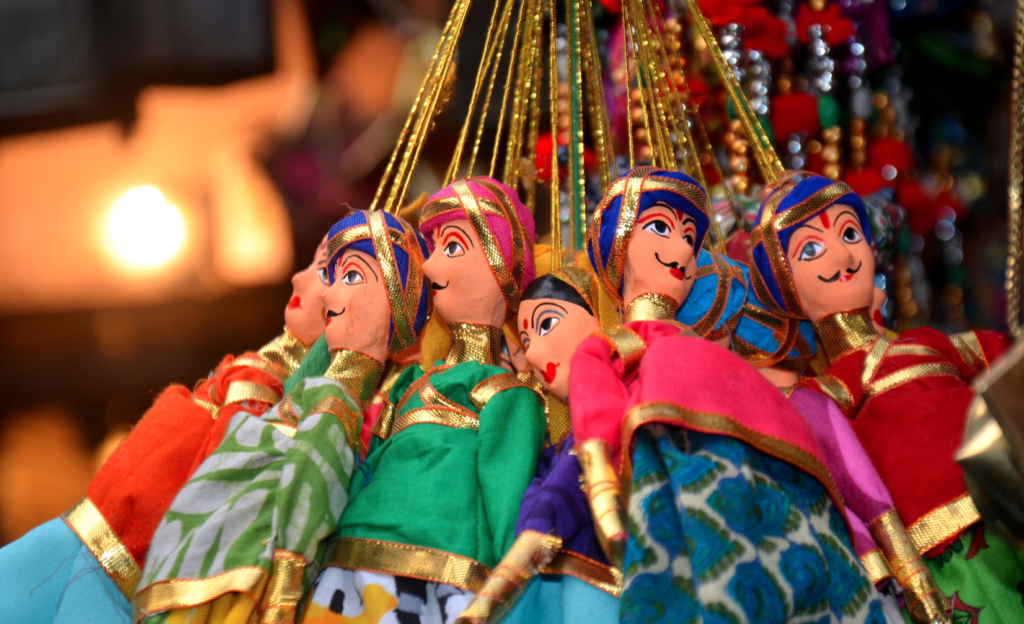
Rajasthani Kathputli dance is one of the most famous folk dances of Rajasthan also known as Puppetry Dance.
It is a tradition of depicting old stories of mythologies and legends through puppets in Rajasthan as a source of entertainment. The Kathputli dance is famous for folk tales and stories. The folk stories are believed to disseminate the lifestyle of ancient Rajasthani tribal people.
The art form originated from the prevailing city Nagaur and surrounding areas.
The popularity of the art form is such that the name of Kathputli dance itself evokes the essence of Rajasthan and its folklore. It is a string marionette which is controlled by a single string that passes from the top of the puppet to the puppeteers.
Sometimes, the show is accompanied by different songs for greater impact.
History of Kathputli Dance
Tribe
The tribe representing this dance form is the Bhati community. Over 1500 years ago, the tribal Rajsthani Bhati community started the use of puppets.
They claim that their ancestors had performed for royal families and received great honour and prestige from the rulers of the state.
Origin of Kathputli Dance
- The art form is known to have originated a thousand years ago by the Bhati community.
- Kathputli name is a juncture of two Rajasthani words ‘Kath’ meaning wood and ‘Putli’ meaning a doll.
- Later when the Bhati community spread their art form to other regions of the state, the art kicked off with the ruling families and became popular.
Present Scenario
- The Mughal period brought a downfall for this art form as it was believed to be against Islamic beliefs.
- It initially began with the purpose of entertainment, further, it was used to spread moral and social education through mythological stories and lessons.
- Different shows broadcasted different problems of the time in order to spread information through puppets such as:
- Dowry system
- Women’s employment
- Illiteracy, poverty
- Unemployment
- Cleanliness
Significance
The loud beats of Dholak announce the beginning puppet show.
Each of the shows has a different theme to it. One of the most popular themes is that of the dialogues of Amar Singh Rathore of Nagaur.
In India, puppet troupes are found in states like Rajasthan, Andhra Pradesh, Maharashtra, Kerala, and Karnataka.
The puppet shows were formed to not only entertain people but also spread awareness, teach and persuade. It is a flexible means of communication of artistic expressions. They have the power to help communities grow and change.
Costume of Kathputli Dance
There is no such particular costume for the performers since the performers are not living beings. It is a string marionette which is controlled by a single string that passes from the top of the puppet to the puppeteers.
5. Kachchhi Ghodi
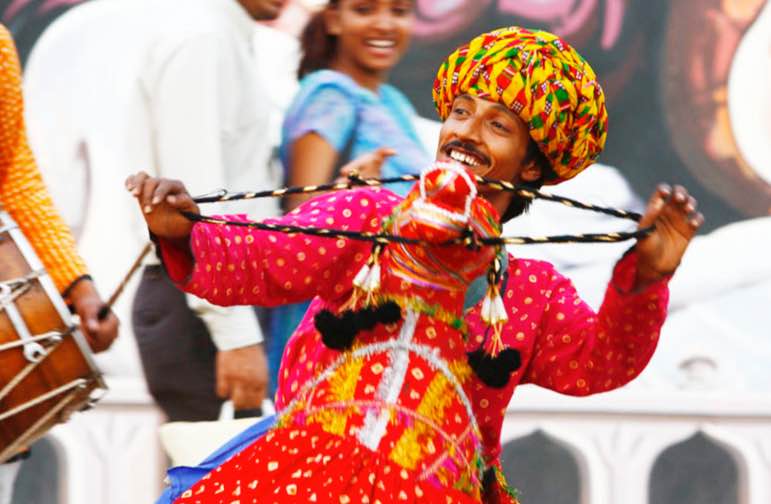
The intriguing dance form is known for its unique and creative costumes. The dance form is performed by men on dummy horses by the men wearing beautiful traditional costumes with embellishments and mirror work.
The dancers ride on the dummy horses and move to the beats of drums, fifes and another instrument called Bankiya and Thali while the singer narrates folk tales about local bandits.
The dummy horses used as a prop are equally decorated with beautiful embroidery and mirrored work. The dancers ride with a sword in their hands.
History of Kachchhi Ghodi
Tribe
- The art form is prevalent in the Kamdholi, Sarghara, Bhambi, and Bhavi tribe communities.
- The Kachchhi Ghodi dance form originated in the Shekhawati region of Rajasthan.
- The dance portrays the confrontation of the Bandits of the Bavaria Clan of tribes with the passing commoners.
Origin of Kachchhi Ghodi
- It was inspired by the tales of Bhanwariya bandits of Shekhawati region who performed the role of Robin Hood where they would rob rich merchants only to distribute the loot among the poor.
- An alternate theory reveals that the inspiration was drawn from the tale of folk deity Baba Ramdevji of Runicha Nagri, Jaisalmer.
- According to this theory, Baba Ramdev Ji was fond of toy horses, which led to a miracle and in conclusion, this dance form was formed.
- The reason for the dummy horse was to symbolise the royal strength that was evident with the loyal and royal vehicle of Rana Pratap Singh, Chetal.
- Horses being the symbol of royal power were used by bandits on highways to stop people travelling on elephants or bullock carts easily.
Present Scenario
- The Shekhawati dance is performed usually for the entertainment of the bridegroom’s party.
- The performers play the part of the brave yet benevolent bandits of the Shekhawati region of Rajasthan known as Bavaria.
- The songs in the Kachchhi Ghodi are generally about the overt businessmen and traders of the Shekhawati region of Rajasthan.
Significance
- The dance is performed on dummy horses with naked swords in their hands while the singer narrates the exploits of Bavaria bandits.
- The dance uses mock fights and brandishing of swords, nimble sidestepping, and pirouetting to the music and drums of the fife.
- A ballet singer usually sings exploits of bandit Robin hoods of Rajasthan.
- The dance form is reflective of the socio-historical scenario particularly depicting the time or race of their time.
- When performed as a group dance, people stand on opposite sides with swords in their hands and run back and forth quickly, when viewed from above, resembles the opening and closing of flowers.
Costume of Kachchhi Ghodi
- Kachchhi Ghodi is the imitation of a horse costume worn around the waist.
- Men wear elaborative costumes embroidered with amazing mirror work.
- They wear novelty horse outfits and represent themselves as the warriors of ancient times.
- The men are dressed in a kurta and a turban. The prop is a dummy horse supported by a bamboo frame.
- It is covered with bright-coloured fabric designed with mirror-work embroidery known as ‘Shisha’.
- The fabric is draped around the performer’s waist covering the entire length of legs.
- Around the ankles, the dancer wears musical bells known as ‘Ghungroo’.
6. Gair Folk Dance

Gair dance form is again one of the most famous dance forms of Rajasthan. It is one of those few dance forms that involve both men and women. Dandi Gair and Geendad are variations of this popular dance form.
It is performed within the circular formations surrounding the singers and musicians. During each turn, they fall in, they beat the sticks and create a thumping beat that goes along with the melody. First, they move clockwise and then anti-clockwise.
History of Gair
Tribe
It is one of the many dance forms by the Bhil community. Gair is performed by all communities but more famous in Mewar and Marwar regions of Rajasthan.
Origin of Gair
- The dance form got its origin from Bhil dance forms.
- The Dandi Gair is found in Marwar region and Geendad is found in Shekhawati region of Rajasthan.
- The Bhil community of Rajasthan is one of the Adivasi groups of India.
- During the Rajput rule, they were provided with employment such as hunters or army personnel.
- It is believed that the formations and movements of the form is inspired by the military lives of the Bhil people.
Present Scenario
- This form of dance is seen in Asia and Central Asia.
- Gair is performed by chanting the name ‘Priyanka’.
- Men dance in big circles while the singers sing folk songs and they dance to the beats of Dholak, Nagada, dhol, they use sticks known as Khanda.
- Originally it was performed by both men and women but now it is predominantly performed by women.
- The Gair variant that is performed in the Mewar region involves performing the dance in a concentric circle rather than one circle.
Significance
- Though it can be performed on several occasions, it is mainly performed on Holi and Janmashtmi.
- The striking of the sticks by men gives the dance a vigorous character and a consistent tempo.
- The Gair means ‘circle’ in the regional language and performs within circular formations.
- To enjoy this kind of folk dance, various spectators from different countries arrive in the state every year.
Costume of Gair
- The dancers are dressed in traditionally colourful long pleated tunics that open into full-length skirts.
- These tunics can be either white or red in colour and may be embellished with either silver or gold Gota Patti Work on the pleats and the borders as well.
- These kurtas are paired with white churidar pants and saffron colour turbans.
- The costume also includes a simple cloth around the waist like a sash in a similar colour to that of the kurta.
- The Accessories that go with the costume are heavy. The men tie Ghungroos around ankles.
- The performers also carry swords and a shield that is fastened at the back.
7. Chari Folk Dance
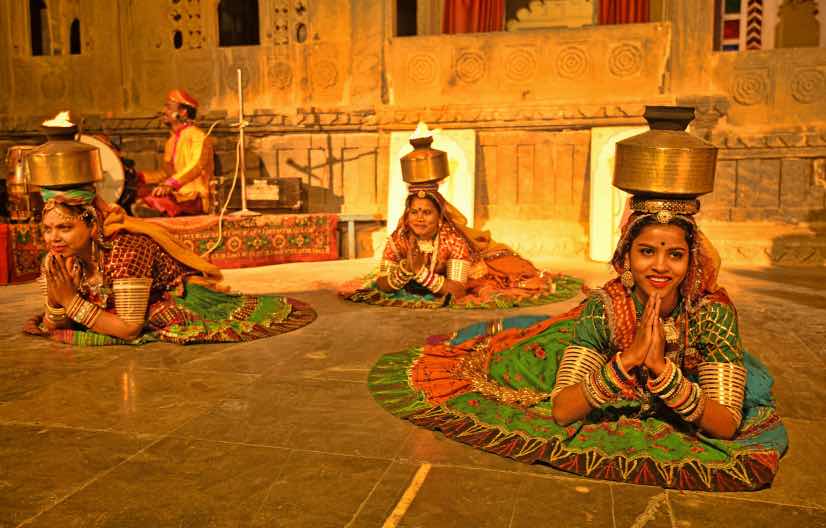
Chari is a Rajasthani folk dance form performed in groups. It is only performed by women. It is very renowned and usually performed at joyous occasions.
In this, women dance with a earthenware or brass Chari pots on their heads. Often the Chari is set on fire with cotton seeds immersed in oil. They carry the pot on their head without touching it.
History of Chari
Tribe
Chari dance is a speciality of the Gujjar community of Kishinaganj in Rajasthan and is prominent in the Saini community of Ajmer. The dance is performed by the womenfolk of Rajasthan’s rural area.
Origin of Chari
It was believed that this dance form was mainly developed like the Bhavai dance. Rajasthan being a desert area, women used to walk for several miles to collect water from the wells for their families. This dance form got inspired through that act. They used to collect their daily water in Chari. The dance celebrates the lifelong ritual of collecting water.
Present Scenario
The joy of collecting water with other women is reflected through this dance form. The hands remain free and dancers move their hand and foot effortlessly. The dance is accompanied by Rajasthani’s folk music that is played with dhol, dholak, nagada and harmonium during the dance.
Significance
- Chari dance is performed during festive and special occasions like a marriage ceremony or when a child is born into the family.
- Often they place a lighted lamp on their head that leaves spectators in awe.
- The music and colour of this dance is a contrast to the dull dry climate of this region. It brings energy and vibrancy.
- The style they perform is also like Ghoomar.
Costume of Chari
- Since this is only performed by women, the costume involves a lot of ornaments.
- The costume involves the basic Ghagra and Choli where the Ghagra id designed above the traditional lehenga allowing wide horizon for the performers.
- The jewellery entails:
- Hansli
- Timniya
- Mogri
- Punchi
- Bangdi
- Gajra
- Armlets
- Karli
- Kanka
- Navr
- Gujjar ladies wear big nose rings on top of their heads.
8. Chakri Folk Dance
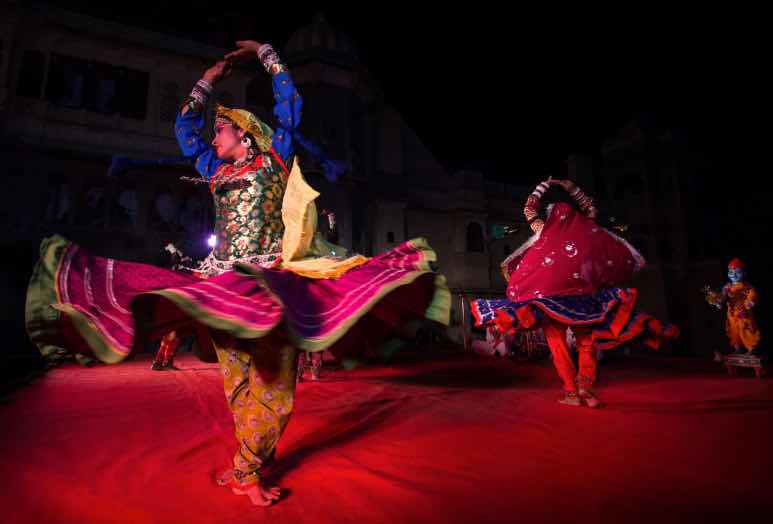
As the name suggests ‘Chakri’ means Circle. It is one of the most popular folk dance forms performed by women. It is generally performed in groups who are clad in veils. It highlights the circular motion of dancers sitting on their knees, twirling round in circles.
The Chakri dancers are accompanied by the group of skilful traditional singers who sing as the women start to dance. Dholak and Nagara are the main instruments used in the dance.
History of Chakri
Tribe
- Chakri is a popular folk dance of Kanjar tribe inhabited in some parts of Kota and Baran district of Rajasthan.
- It is believed to be similar to the Raai dance of ‘Beriyas’ tribe of Madhya Pradesh.
Origin of Chakri
- It is found in nearby places of Chhipa Baroda, etc.
- The dance is accompanied by traditional songs where male performer produce a robust rhythm on the Dholak musical instrument.
- This form is an integral part of the culture of Rajasthan.
Present Scenario
- Some of the these dances are performed by men and some by women.
- The dances by men are more acrobatic and require jumping skills whereas the women dance with grace.
- The women dance for their livelihood.
- The dance is really fast and agile, the music is of utmost importance.
- The women also sing when they dance.
- The music has a high tempo.
Significance
- The women who perform this dance form are experts, they belong to the villages where literacy rates aren’t great.
- They make out a living of this, which they are best at.
- Several women and girls get paid to perform at weddings.
- Chakri dancers perform at other events as well such as when the groom’s party arrives at the wedding venue or when the couple gets blessed with a new member or at Mehendi too.
- The women cover a large area as they keep moving without clashing with each other.
Costume of Chakri
- The dancers wear colourful skirts with a lot of Rajasthani mirror work and the whole group looks bright and colourful as they go in rounds.
- They are laden with rainbow-coloured outfits.
So, these were the main Rajsthani folk dance forms performed by both men and women in the state of Rajasthan. The origin of these forms traces back thousands of years ago and holds a lot of essence towards its culture. Rajasthan is known for its royalty, and these folk dance forms are the ones that contributes to the highly majestic culture.
Also Read – Top 10 Indian Classical Dancers of all times




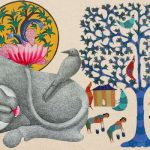


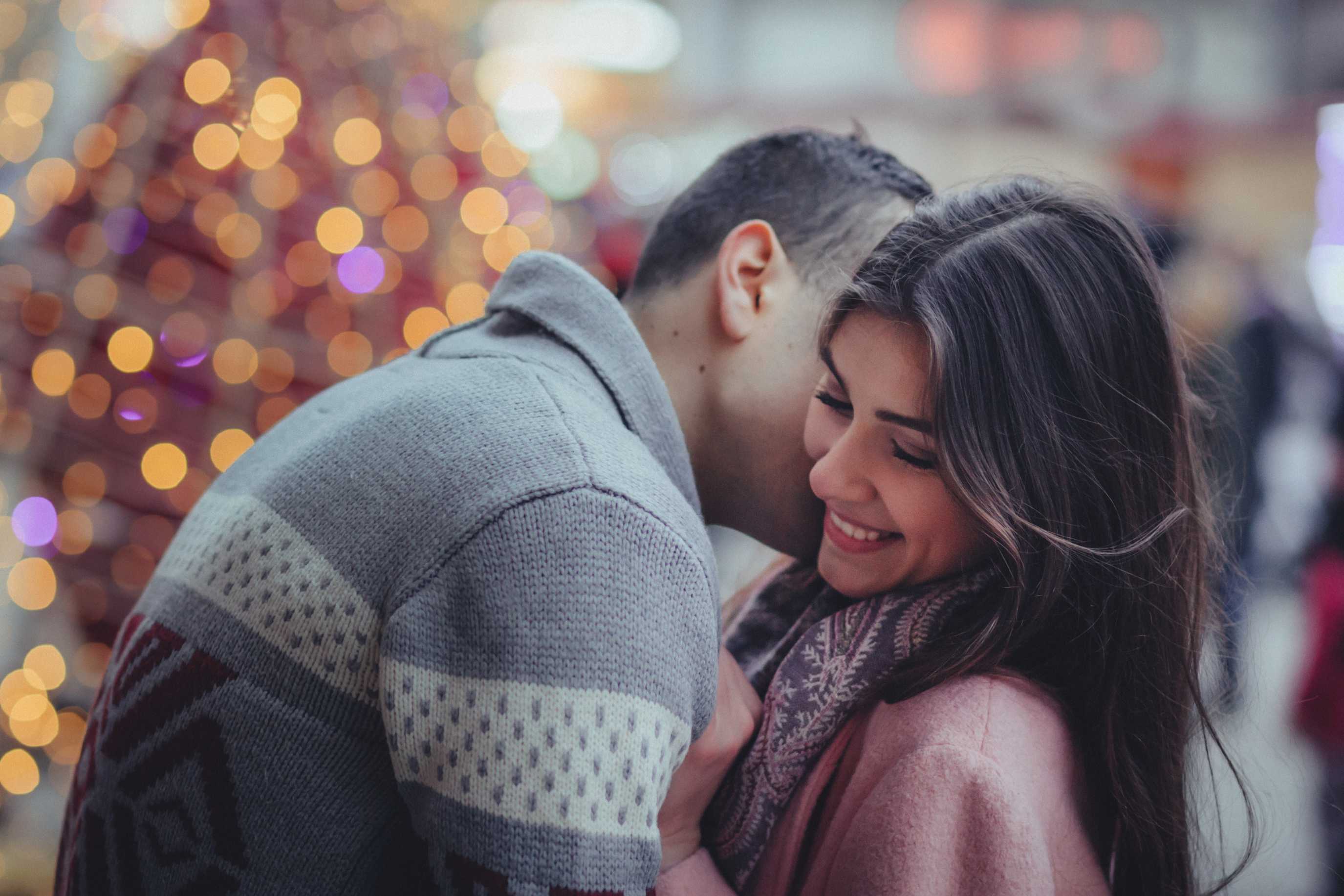


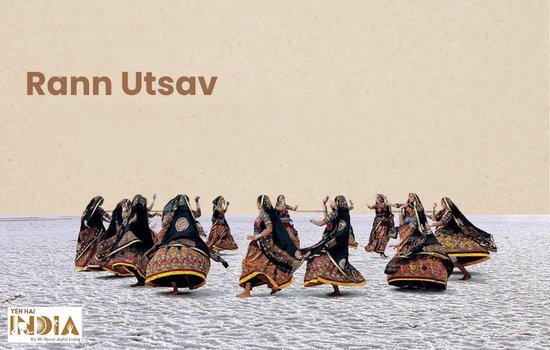
Hi Bishaka,
Great capture of the beautiful Rajasthani dances. They are very colorful and elegant.
I am based in USA and like Indian Rajasthani dances a lot.